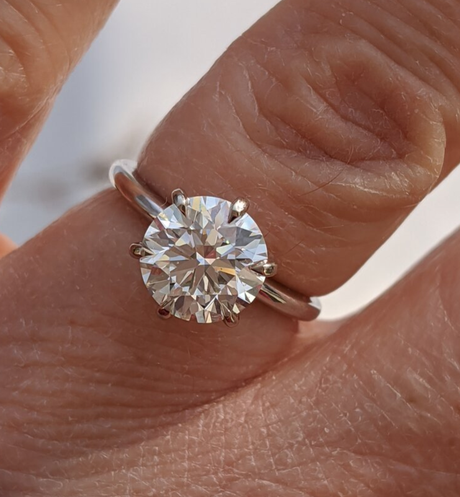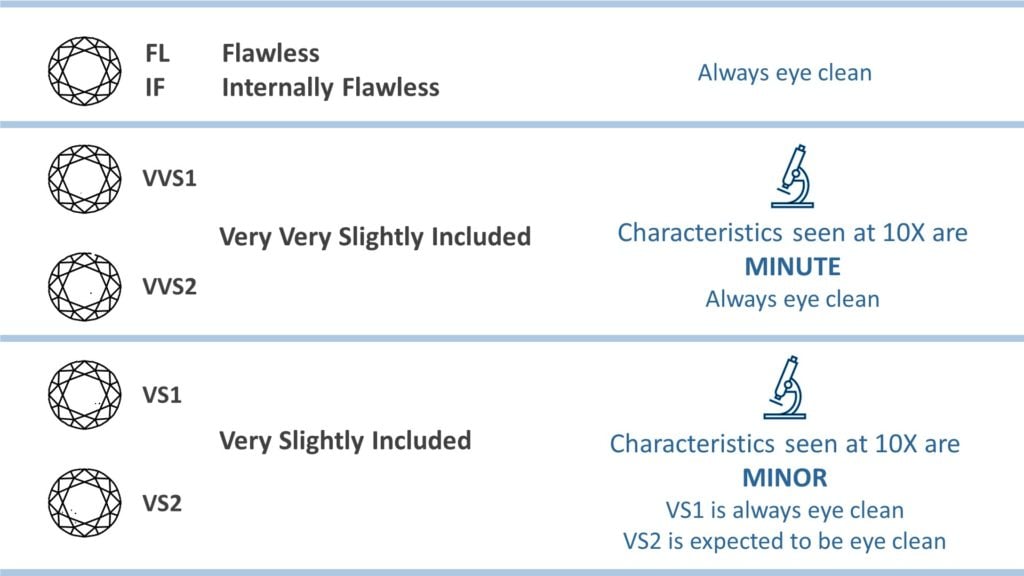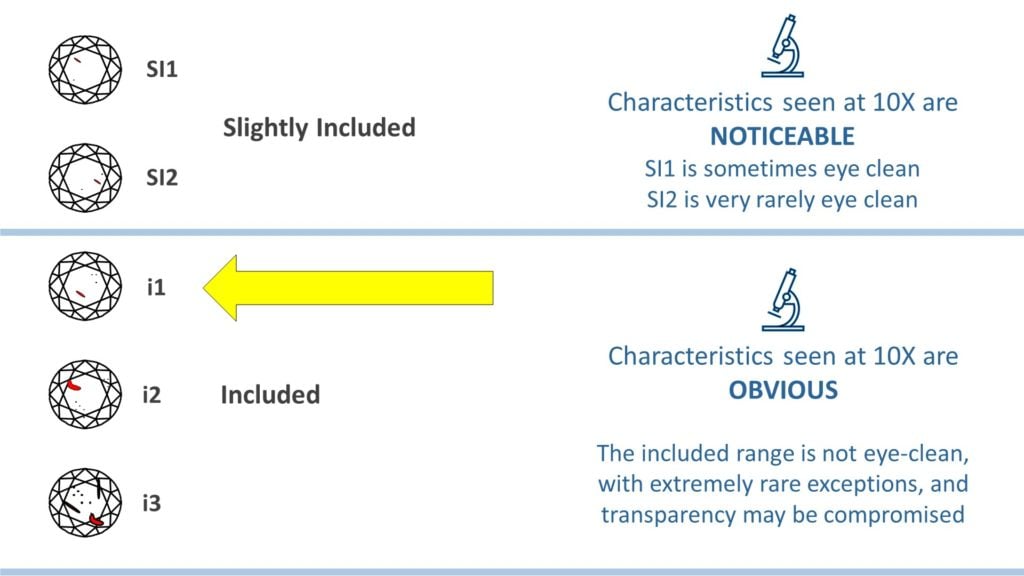How Are Diamonds Made? Natural vs Lab-Created Explained
Two Paths, One Diamond Not all diamonds come from the same place — but they all start the same way. Pure carbon, crystalized under immense pressure and heat. Whether it…
I1 Diamond – Basics
If you’re looking for a bargain, I1 diamond clarity presents opportunity, but only if you know what to look for and what to avoid. Here is useful information when considering the purchase of an i1 diamond.
PriceScope Pointer: If you’re seeking an i1 diamond with no visible inclusions, be sure you have a clear definition for “eye clean” like the one we will provide below.
Before going on: Check out the PriceScope Diamond Buying Guide
The diamond clarity grade describes a stone’s relative freedom from internal characteristics, classified as inclusions, and surface characteristics, classified as blemishes.
An i1 diamond is one with inclusions which are obvious to a gemologist when using 10X magnification, and possibly without magnification. In fact, the “I” in I1 refers to the “included” range, used to describe the lowest three grades on the clarity scale. That range spans three levels, where an I1 diamond lands at the top and an I3 diamond lands at the bottom. One or more of the following is typical of diamonds in this range:
An i1 diamond usually has inclusions and/or blemishes which have a moderate impact on its beauty or durability. Certain i1 diamonds have inclusions or features which are somewhat difficult to find by the unaided eye. Others have characteristics which are immediately evident. At the i1 diamond clarity level opaque inclusions are frequently seen when the diamond is placed against a light background.
Wondering which of the many diamond colors is best for you? Our elite list of vetted vendors like Whiteflash and James Allen are experts at listening and helping you determine which combo of the 4Cs is perfect for you - and nicely in budget. Contact Us and get help today.
In extremely rare instances an i1 diamond has inclusions numerous or significant enough to land in the “included” range, without being visible to the naked eye. Since most people just want an “eye-clean” diamond, meaning one which has no inclusions invisible to the naked eye, this can present an opportunity for bargain hunters.
There is no laboratory definition for eye-clean, but a PriceScope survey of gemologists resulted in this consensus:
 Photo Courtesy of PS Member Soxfan
Photo Courtesy of PS Member Soxfan
Eye-clean = No inclusions visible to the unaided eye when viewed from the face up position in daylight equivalent or fluorescent lighting from approximately 6 – 12 inches from the eye using 20/20 vision.
We don’t recommend I1 diamonds without in-person inspection, or purchase from a seller you trust to reliably convey details about the specific diamond being considered. Even diamonds which look clean in photos and videos may have issued with transparency or light transmission, which is frequently the reason a diamond will be relegated to the “included” range: I1, I2, or I3.
An i1 diamond that is perfectly transparent but has a significant or obvious inclusion may be problematic because that characteristic can draw the eye of viewers. With that said, depending on location, they may have a “prongable” inclusion, meaning one over which a prong can be placed, reducing its visibility in the face up position.
PriceScope’s 1-5 star ratings are categorical comparisons with the most thorough, consumer-focused online diamond and jewelry vendors, in categories, we believe reflect our experienced consumer community’s values. Check out PriceScope Jeweler Reviews.
The internationally accepted grading scale and terminology for diamond clarity consists of 11 grading levels. Grading is traditionally performed using 10 power (10X) magnification. I1 belongs to the “included” range, which lands at the bottom of the diamond clarity grading scale.


A clarity grader will also consider the location, number, color, size, and nature of the characteristics present at 10x magnification when deciding the clarity grade.
If you’re looking to buy loose diamonds online, use our special tools to reveal the best cut quality diamonds! Start your diamond search and choose from over a million loose diamonds for sale. Use our filters to find either natural or lab diamonds, as well as fancy color diamonds.
While the descriptive scale above is universally applied, standards can vary between individuals and organizations that decide I1 diamond clarity.
Variance between reputable graders and organizations may be attributable to standard deviation. Color and clarity judgments are matters of opinion and diamonds often sit on the border of two grades. The only time this becomes an issue is when a buyer and seller disagree about which set of grades establish the diamond’s value.
Intentional over grading has been a historic issue in the diamond trade. Over grading is a willingness to purposely deviate from internationally accepted standards to inflate the perceived value of a diamond. Certain locations of the EGL (now closed) became infamous for over-grading loose diamonds, by 3-4 grades in some cases, permitting unscrupulous sellers to overcharge consumers.
Under grading occurs when a jeweler examines a diamond and claims it was over graded to create fear-based doubts in the diamond owner’s mind. The most frequent example of under grading is when one jeweler implies a consumer overpaid a competing jeweler, hoping the consumer will return the diamond and purchase there, instead.
Get quick answers to any question now: Ask our community of unbiased independent helpers.

Retail Diamond Prices Chart Updated Monthly.

Two Paths, One Diamond Not all diamonds come from the same place — but they all start the same way. Pure carbon, crystalized under immense pressure and heat. Whether it…
A Wedding Ring as Unique as Your Love Finding the right wedding ring isn’t just about diamonds or gold – it’s about finding the one that feels right. With hundreds…
So, you’re thinking about lab-grown diamonds? Smart move. They’re just as sparkly as the natural kind but usually cost less. But where do you actually go to buy them? It…

Want to stay updated on the most recent blogs, forum posts, and educational articles? Sign up for Bling News, PriceScope’s weekly newsletter.